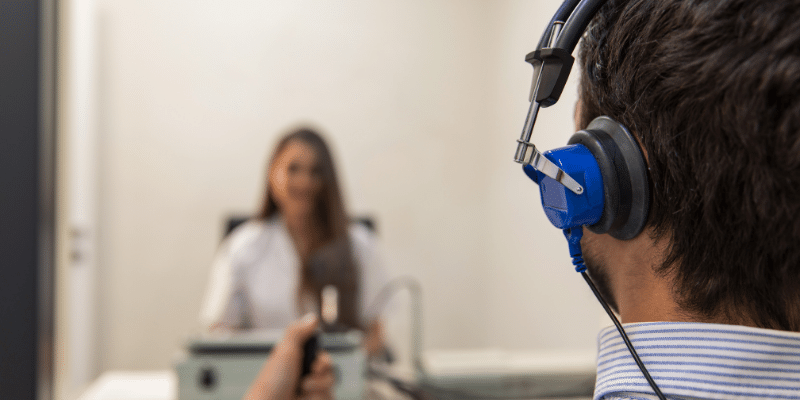Hearing Loss is a common symptom.
Once patients come with a history of hearing impairment, the simplest and most common hearing test that is carried out is the Pure Tone Audiogram (PTA).
It is so-called because an instrument (Audiometer) is used to produce Pure Tones at different frequencies – these are then presented to the subject at different sound levels (Volume) and the patient’s hearing is recorded.
TEST METHOD
The test is carried out in a soundproof chamber to elicit an accurate response.
It is preferably carried out in a two-room setting with the Tester and the Tested in a different room.
Two different responses are tested
- Air Conduction – tested with Headphones
- Bone Conduction- tested with a Bone Vibrator
The Bone Vibrator and the Headphones are snuggly fitted and the test is started by producing sound – usually starting at 1000 Hz at 25 dB. The tested is instructed to press a button when a sound is heard.
The frequencies are then tested one by one and a graph is plotted – Frequency on the X-axis and Volume on the Y-axis.
TEST RESULTS
Test results are interpreted on two criteria
- Type of hearing loss
- Degree of hearing loss
Type of Hearing Loss
There are Three Types of hearing loss
- Conductive Deafness – caused by abnormalities of the External ear and Middle ear, including perforation of the eardrum and middle ear infections.
- Sensorineural Deafness – caused by abnormalities of the Inner Ear (Sensory) or the Acoustic nerve (Neural)
- Mixed Deafness- caused by a combination of the two- as when a middle ear infection leaks into the inner ear to cause damage to the Cochlear hair cells, etc.
Degree of Hearing Loss
Based on the Decibel level (Volume) at which sound is heard
- < 15 dB Normal hearing
- 16-25 dB Minimal hearing loss
- 26-40 dB Mild
- 41-55 dB Moderate
- 56-70 dB Moderately Severe
- 71-90 dB Severe
- >90 dB Profound
There are other tough to test situations where a battery of tests would be ordered. Examples of these are
– Auditory Processing disorder – in which case some other tests would be offered
– Non Organic Hearing Loss- Feigning hearing loss in the presence of normal hearing – as in malingering (for compensation, avoidance of duty, etc) or Functional hearing loss. There are some elaborate tests that can be carried out for detection.
CROSS HEARING AND MASKING
In the presence of Asymmetrical Hearing Loss sound given to one ear may cross over to the other ear (Non-Test Ear) – this is Cross Hearing.
To get an accurate reading in these instances the non-test ear is given a sound of the same frequency at a lower volume to prevent cross hearing- a process called Masking.
To summarize, a Pure Tone Audiogram is a reliable method to diagnose the type and degree of hearing loss a patient has.
It should preferably be done in a soundproof room by an experienced Audiologist.

